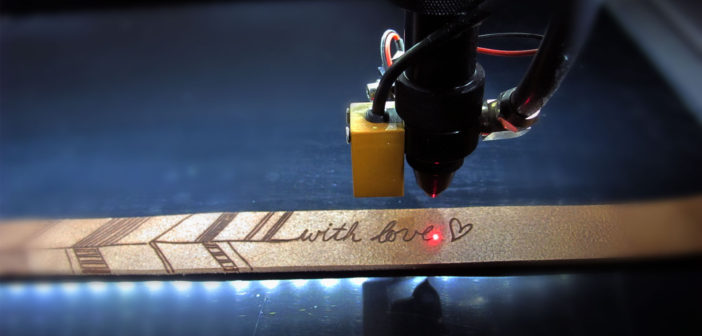Laser engravers, laser cutters and laser markers are all effective, specialized machines engineered for crafting unique commemorative and promotional items, such as imprinted logos or engraved awards and plaques. Each has its own set of strengths and capabilities, which are helpful to know when selecting the appropriate application. Following is a brief introduction, including many pros and a few potential outcomes to bear in mind.
Laser Engravers
Laser engraving entails the removal of material so as to create depth in a specific series of shapes or patterns. This engraved surface collects and reflects light, which makes the shape of the created depth more apparent. Think of an engraved ring or locket. Laser engravers permit skilled craftsmen to cast a large assortment of fine details onto small parts. Consequently, laser engravers are particularly suited to engraving small items, such as numbers or letters on jewelry or metallic tags.
With laser engraving of jewelry in particular, there is the possible risk of oxidation or rusting to the engraved surface, exposed by laser. The jeweler or vendor selling the product may be able to offer advance warning about pieces more prone than others to oxidation and rusting after being laser-engraved. Luckily, there are other options to consider when attempting to adorn hard or metallic surfaces with laser engraving.
Laser Markers
Laser marking encompasses laser engraving, which is one of its subsets. According to LaserPro, laser marking is a slightly wider category that refers to leaving marks on a surface with a laser, but it does not require removing material to create depth. With a laser marker, the heat from a laser disrupts the carbon molecules on the surface of an object, which creates a mark. Laser marking also connotes the use of chemicals that react and cause color changes so as to mark a surface.
Since laser marking only involves the disruption of surface molecules, laser-marked metallic items aren’t exposed to possible corrosion of rust. This is a key consideration when the items to be marked are important, go-to items or luxury keepsakes, such as tools for surgical, automotive and home improvement use or expensive, special-occasion jewelry. Personalizing such tools and jewelry is a thoughtful gift idea and also ensures there is never any confusion about who owns the laser-marked tool or pendant in question.
Laser Cutters
Laser cutters are quite different from laser engravers and laser markers in that they cut completely through materials. However, some laser cutters can engrave as well as cut, and even skilled craftsmen may use a laser cutter to engrave a pattern first before cutting the finished pattern.
Laser cutters work by agitating a gaseous medium, usually carbon dioxide. The medium amplifies the light, which a lens then focuses. Laser cutters appear in an enormous range of project types, from arts and crafts to hardcore engineering. The major plus about laser cutters is their inherent exactness, which allows most laser cutters to reproduce multiple identical copies of a prototype, pattern or design.
A laser cutter can section a piece or cut shapes directly through a material. This type of cutting excels in manufacturing processes that require the precision cutting of hard or soft materials to create prototypes. According to Stanford University, some laser cutters are unsuitable for cutting PVC, vinyl, fiberglass, polycarbonate or rubber. Doing so may produce toxic or noxious fumes, start a fire or damage the laser cutter.
Most laser cutters can safely cut cloth, plastic, natural leather, metal and many types of wood. Laser cutters, when used to engrave or cut, create very precise patterns with a distinct silhouette that appears to have more dimension than a typical engraving.
While laser engravers, laser cutters and laser markers each have their strengths, one type may be a wiser choice depending on the project, the application and the material to be engraved, marked or cut. Conducting a little research is the first step toward making the most fitting choice.




